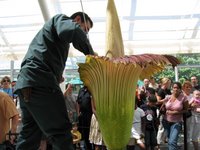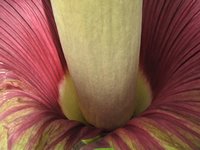Rose Hell

I arrived in Pennsylvania's Brandywine Valley for the Garden Writers' Association convention Friday and before I knew it, I was in Hotel Hell.
My husband and I were in our room at the Radisson watching TV. Our room was called a "themed suite." It was small, dark and windowless and if there was a theme it could have been called "Decorator's Nightmare." We weren't very happy to begin with because one of our bags had disappeared from the hotel's luggage room while we were waiting for our themed suite to be ready. Suddenly, the TV went dead, the ceiling rumbled, the walls shook. The lights went out. We opened the door and found hallway ceiling tiles falling and a torrent of water gushing down. We weren't in the penthouse -- we were on the first floor. Other guests were rushing out of their rooms. "It's raining on my bed," a woman yelled.
A tornado had hit the Brandywine Valley. I kid you not. Maybe it was the tornado that was supposed to hit the Bronx.
Except for the hallways and the lobby, the lights were out. The water was out. Afterwards, we learned that falling roof tiles had totaled a car in the parking lot. We decided to go to sleep. But without air conditioning, we woke up an hour later gasping. So we took our pillows and joined the people camping out in the lobby, where the door was open to the breeze and bottles of cold water were distributed. Garden writers are a resourceful bunch, and I had to admire a woman who was walking around with a miner's light shining from her forehead. A Baptist convention was also taking place at the hotel and I have to say that the Baptists were taking it in stride. "This is terrible," one man said to a companion. He paused momentarily and added, "but we're blessed."
By morning, the water was was running again -- in the bathroom that is -- and the electricity was back on. I can't say I felt blessed. But after two hours of sleep on a couch in the lobby, and the assurance that my husband and I would be moved to a different room without a them, I got on a bus with other garden writers from across the U.S. and Canada to the trial gardens of Conard-Pyle, one of the largest rose breeders in the world.
And suddenly, I was in Rose Hell.
This time, I didn't mind. It was hell for the roses -- not for us. We treked into a dusty field on the 375-acre facility to see what it takes for roses to get the Conard-Pyle seal of approval and make it into your garden and mine.
"Welcome to rose hell," said a charmingFrenchman named Jacques Ferare, who sounded like Maurice Chevalier. I thought that any minute he would break out into song. Instead he told us, "It's like boot camp for roses. We're known for plant abuse. We don't irrigate or spray, we may or may not trim. It's less than benign neglect, which is the way most Americans garden."
Long rows of more than 500 varieties of shrub roses -- identified only by numbers -- sat baking in the August sun. "We put them out here and leave them out here," Jacques said. "Then for three years, we just watch what happens."
This is what happens: Sun and drought fry them. Blackspot stains them. Japanese beetles attack them. I've never seen so many Japanese beetles as I saw on the yellow flowers of rose #034096. "If a rose can survive here," Jacques said, "it can survive anywhere." He was impressed by the beetles. "They were very bad this year. I can't ever remember still seeing Japanese beetles in August."
One rose that survived beautifully was Rainbow Knock Out, a hot number these days that was hybridized by Bill Radler of Wisconsin. Bill was at Conard-Pyle too. He hit the horticultural jackpot a few years ago when he created Knock Out, a cherry-red beauty. "I knew when a neighbor who never liked any of my roses finally complimented me that I was on to something," he said.
Rainbow Knock Out just won the All-America Rose Selections award for 2007. It's a coral pink rose with a yellow base that's impervious to black spot. Bill is working on Honey Knock Out, a yellow-white rose to be introduced next year. "I'm still working to get everything right," he told me.
By late afternoon, we were back in the hotel. I should tell you that the staff at the front desk showed grace under pressure during the storm. My husband and I couldn't wait to get into our new room, which has electricity, running water, a large window and a working john.
It seems like heaven.











